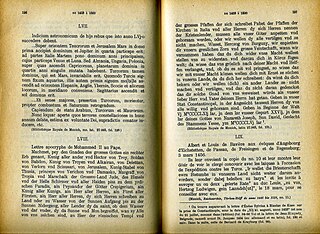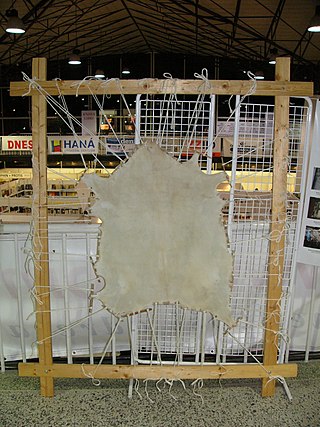
Apocrypha are biblical or related writings not forming part of the accepted canon of Scripture. While some might be of doubtful authorship or authenticity, in Christianity, the word apocryphal (ἀπόκρυφος) was first applied to writings which were to be read privately rather than in the public context of church services. Apocrypha were edifying Christian works that were not considered canonical scripture. It was not until well after the Protestant Reformation that the word apocrypha was used by some ecclesiastics to mean "false," "spurious," "bad," or "heretical."

A manuscript was, traditionally, any document written by hand or typewritten, as opposed to mechanically printed or reproduced in some indirect or automated way. More recently, the term has come to be understood to further include any written, typed, or word-processed copy of an author's work, as distinguished from the rendition as a printed version of the same.

Parchment is a writing material made from specially prepared untanned skins of animals—primarily sheep, calves, and goats. It has been used as a writing medium for over two millennia. Vellum is a finer quality parchment made from the skins of young animals such as lambs and young calves.

Vellum is prepared animal skin or membrane, typically used as writing material. It is often distinguished from parchment, either by being made from calfskin, or simply by being of a higher quality. Vellum is prepared for writing and printing on single pages, scrolls, and codices (books).
Oxford University Press (OUP) is the publishing house of the University of Oxford. It is the largest university press in the world. The first book was printed in Oxford in 1478, with the Press officially granted the legal right to print books by decree in 1586. It is the second oldest university press after Cambridge University Press, which was founded in 1534.

Plywood is a composite material manufactured from thin layers, or "plies", of wood veneer that are glued together with adjacent layers, having both glued with each other at right angle or at 90 degrees angle. It is an engineered wood from the family of manufactured boards, which include plywood, medium-density fibreboard (MDF), oriented strand board (OSB), and particle board.

Filter paper is a semi-permeable paper barrier placed perpendicular to a liquid or air flow. It is used to separate fine solid particles from liquids or gases.

The Gutenberg Bible, also known as the 42-line Bible, the Mazarin Bible or the B42, was the earliest major book printed in Europe using mass-produced metal movable type. It marked the start of the "Gutenberg Revolution" and the age of printed books in the West. The book is valued and revered for its high aesthetic and artistic qualities and its historical significance.

Chaff is dry, scale-like plant material such as the protective seed casings of cereal grains, the scale-like parts of flowers, or finely chopped straw. Chaff cannot be digested by humans, but it may be fed to livestock, ploughed into soil, or burned.

Octavo, a Latin word meaning "in eighth" or "for the eighth time", is a technical term describing the format of a book, which refers to the size of leaves produced from folding a full sheet of paper on which multiple pages of text were printed to form the individual sections of a book. An octavo is a book or pamphlet made up of one or more full sheets on which 16 pages of text were printed, which were then folded three times to produce eight leaves. Each leaf of an octavo book thus represents one eighth the size of the original sheet. Other common book formats are folios and quartos. Octavo is also used as a general description of the size of books that are about 8 to 10 inches tall, and as such does not necessarily indicate the actual printing format of the books, which may even be unknown as is the case for many modern books. These terms are discussed in greater detail in book sizes.

Lavash is a thin flatbread usually leavened, traditionally baked in a tandoor or on a sajj, and common to the cuisines of South Caucasus, West Asia, and the areas surrounding the Caspian Sea. Lavash is one of the most widespread types of bread in Armenia, Azerbaijan, Iran and Turkey. The traditional recipe can be adapted to the modern kitchen by using a griddle or wok instead of the tonir.

In woodworking, veneer refers to thin slices of wood and sometimes bark that typically are glued onto core panels to produce flat panels such as doors, tops and panels for cabinets, parquet floors and parts of furniture. They are also used in marquetry. Plywood consists of three or more layers of veneer. Normally, each is glued with its grain at right angles to adjacent layers for strength. Veneer beading is a thin layer of decorative edging placed around objects, such as jewelry boxes. Veneer is also used to replace decorative papers in wood veneer HPL.

India paper is a type of paper which from 1875 has been based on bleached hemp and rag fibres, that produced a very thin, tough opaque white paper. It has a basis weight of 20 pounds, yet bulks 1,000 pages to the inch.

A bookmark is a thin marking tool, commonly made of card, leather, or fabric, used to keep track of a reader's progress in a book and allow the reader to easily return to where the previous reading session ended. Alternate materials for bookmarks are paper, metals like silver and brass, silk, wood, cord (sewing), and plastic. Some books may have one or more bookmarks made of woven ribbon sewn into the binding. Furthermore, other bookmarks incorporate a page-flap that enables them to be clipped on a page.

An exercise book or composition book is a notebook that is used in schools to copy down schoolwork and notes. A student will usually have different exercise books for each separate lesson or subject.

Onionskin or onion skin is a thin, lightweight, strong, often translucent paper, named for its resemblance to the thin skins of onions. It was usually used with carbon paper for typing duplicates in a typewriter, for permanent records where low bulk was important, or for airmail correspondence. It is typically 25–39 g/m2, and may be white or canary-colored.

Bookbinding is the process of building a book, usually in codex format, from an ordered stack of paper sheets with one's hands and tools, or in modern publishing, by a series of automated processes. Firstly, one binds the sheets of papers along an edge with a thick needle and strong thread. One can also use loose-leaf rings, binding posts, twin-loop spine coils, plastic spiral coils, and plastic spine combs, but they last for a shorter time. Next, one encloses the bound stack of paper in a cover. Finally, one places an attractive cover onto the boards, and features the publisher's information and artistic decorations.
Woodfree uncoated paper (WFU), uncoated woodfree paper (UWF) or uncoated fine papers are manufactured using wood that has been processed into a chemical pulp that removes the lignin from the wood fibers and may also contain 5–25% fillers. Both softwood and hardwood chemical pulps are used and a minor part of mechanical pulp might be added. These paper grades are calendered.
Samuel Bagster the elder was the founder of the publishing firm of Bagster & Sons.

A colored pencil, coloured pencil, map pencil, pencil crayon, or coloured/colouring lead is an art medium constructed of a narrow, pigmented core encased in a wooden cylindrical case. Unlike graphite and charcoal pencils, colored pencils' cores are wax- or oil-based and contain varying proportions of pigments, additives, and binding agents. Water-soluble (watercolor) pencils and pastel pencils are also manufactured as well as colored cores for mechanical pencils.

















